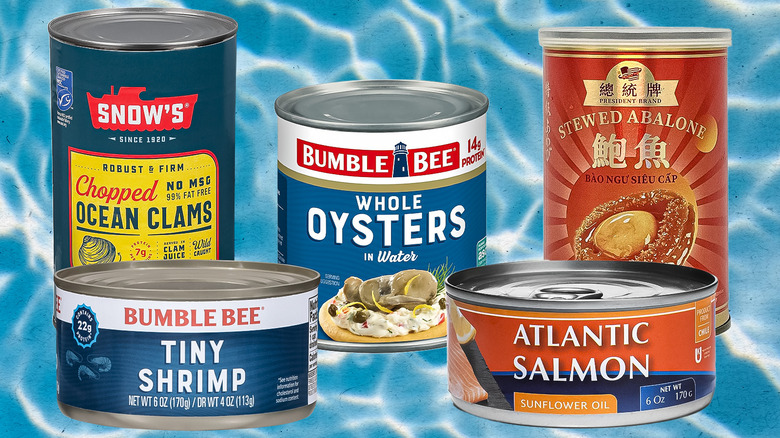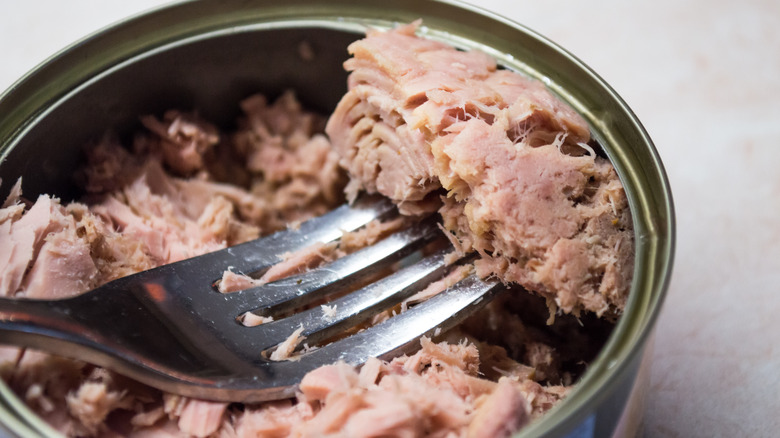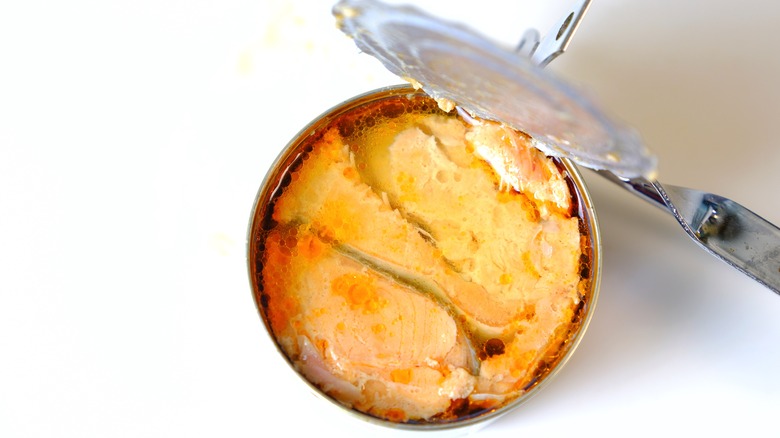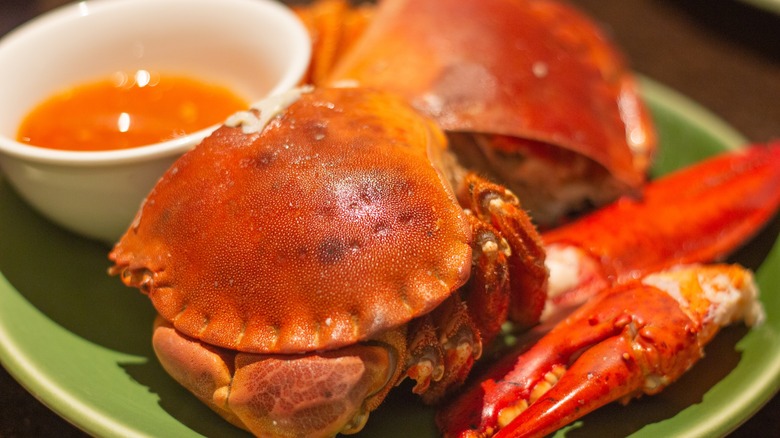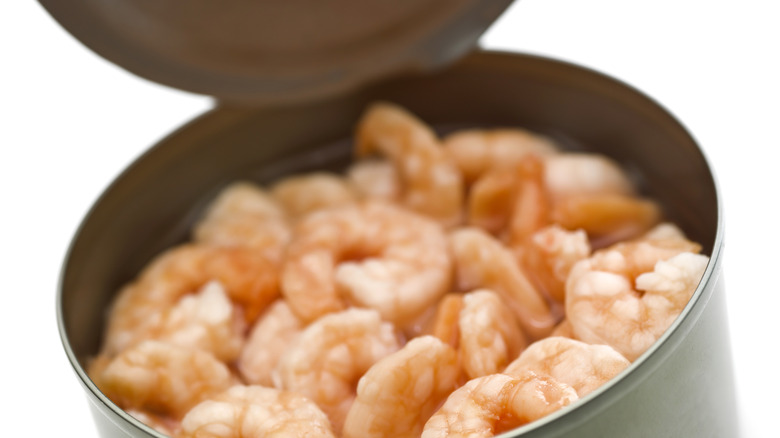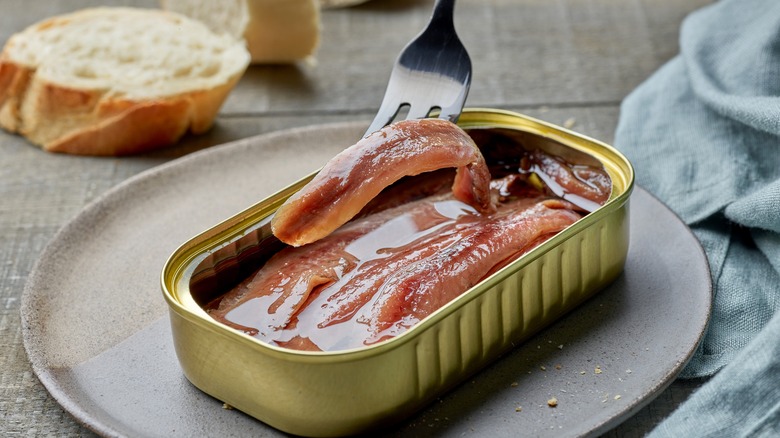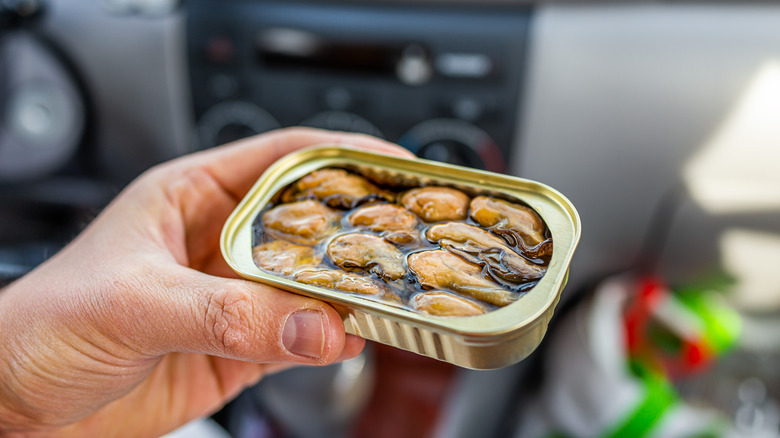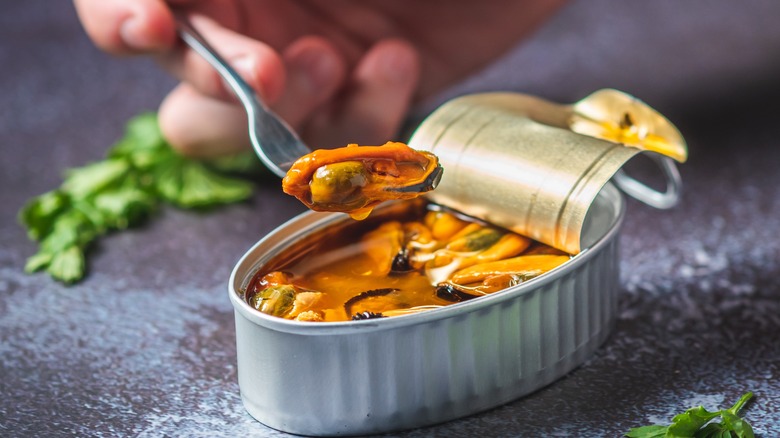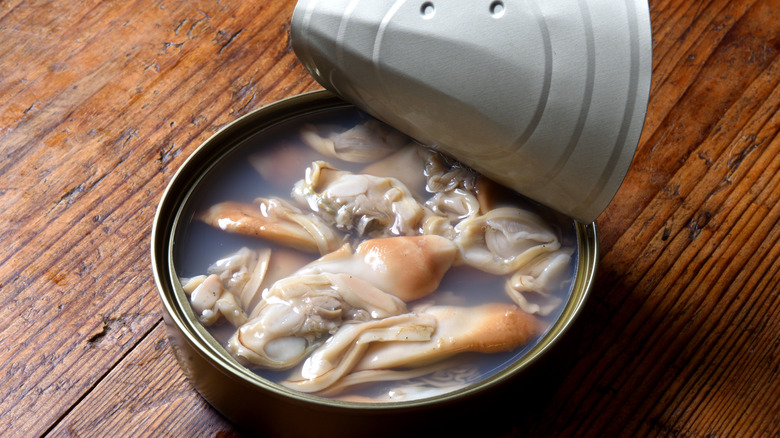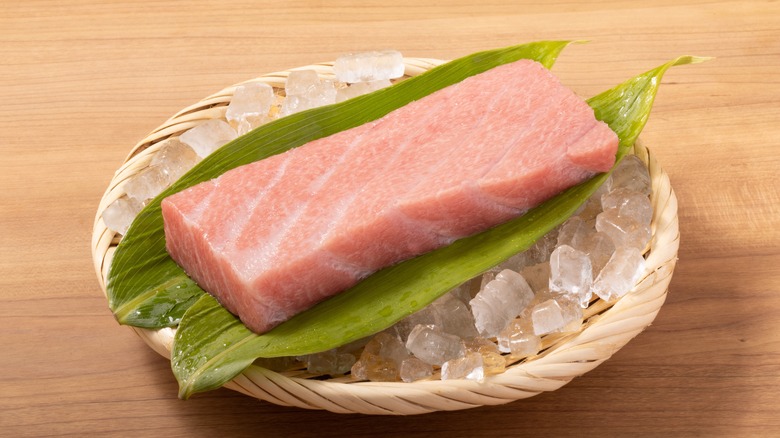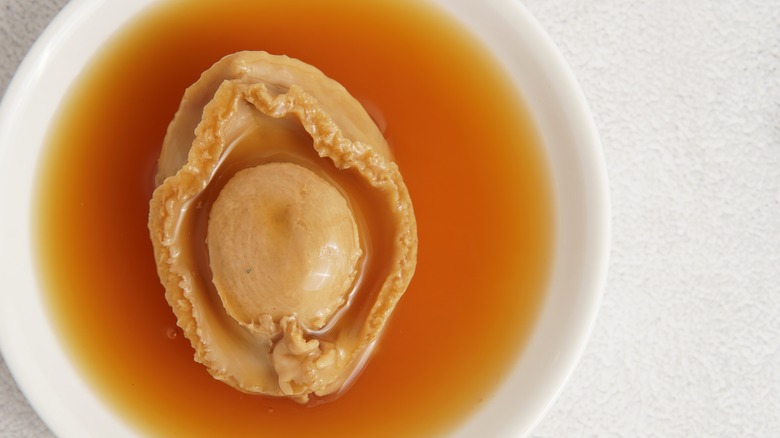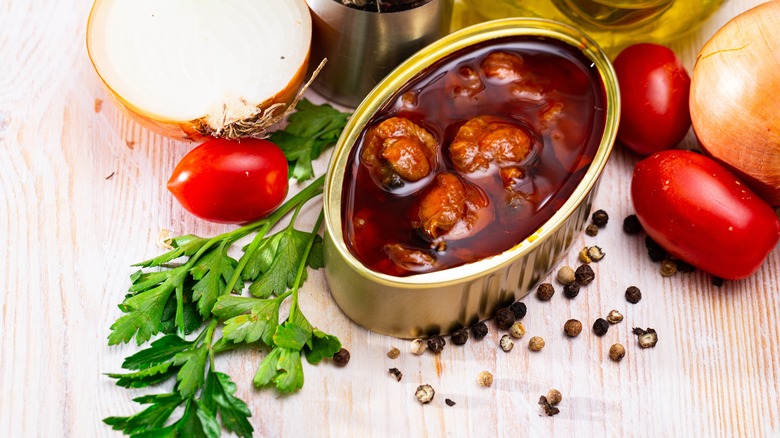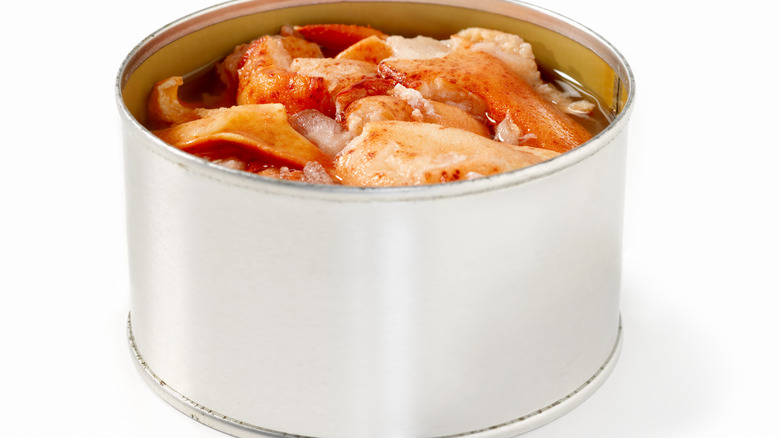The Unhealthiest Canned Fish You Should Avoid
Canning is one of the oldest ways to preserve food, and currently one of the best ways to bring seafood from around the world to your plate. Most canned fish is prepared for the process by first brining in saltwater to draw out moisture and curb bacterial growth, followed by canning in oil or water. The high heat from canning kills the microbes in fish, but not every bacteria is removed in the canning process.
Aside from an elevated salt and fat content from the canning process, what makes certain canned fish unhealthy is its risk of heavy metal contamination, which becomes absorbed in the fish tissue, and any bacterial remnants. Most fish breed in waters containing mercury, cadmium, or lead, and larger fish which have been around for longer are at a higher risk of absorbing the metals at concerning amounts for human consumption. These include Atlantic bluefin tuna, Atlantic or farmed salmon, brown crab, and some crustaceans (shrimp, lobster) and shellfish.
When buying canned seafood, consider brands which are environmentally conscious and do not fish from contaminated waters. They should also have adequate methods of removing any bacteria in place, and tin their fish in controlled nutrient quantities. We take a look at some of the unhealthiest canned fish, based on their nutritional information, and risk of bacterial and heavy metal contamination, as well as some of the specific locations from which to avoid canned fish due to their unclean fishing practices.
Albacore (White) Tuna
Seafood in general may not be at the forefront of the American diet, but tuna is an exception. Americans consume 1 billion pounds of canned and pouched tuna annually — no small number (or feat) and with no small consequences. Although tuna being highly contaminated with mercury is one of the many canned tuna myths, it is true that tuna has a risk of mercury exposure as it breeds in waters which have become contaminated with mercury from events like volcanic eruptions and industrial activity. Alongside absorbing the heavy metal, tuna feeds on smaller fishes contaminated with mercury, and it builds up in their tissues over time.
Tuna species at risk of high mercury exposure include Albacore, Yellowfin, and Bigeye, of which Albacore is commonly canned. Although the U.S. Environmental Protection Agency (EPA) has allotted safe levels of tuna consumption in adults per day and week based on body weight, the levels of mercury in some tuna exceed these limits.
Mercury exposure leads to health issues such as cognitive defects, anxiety, depression, heart disease, and impaired infant development (via Healthline). Populations such as children and pregnant and breastfeeding women are advised by health authorities to not consume tuna and other high mercury fish. The safe varieties of tuna include light and skipjack tuna, which have low mercury contamination and can be consumed in 2-3 servings per week. However, few companies check the mercury levels of each can, even for light tuna, so do your own research before purchasing.
Atlantic or Farmed Salmon
Salmon is a fatty fish consumed for its health benefits and favored taste. Both wild-caught and farmed salmon are a good source of protein, omega-3 fatty acids, vitamin B12 and many essential minerals. However, canned salmon can be high in sodium, as the salt content helps preserve salmon in canning. A regular flat can of salmon contains nearly 700 milligrams of sodium, which is more than ⅓ of the recommended upper limit of sodium intake set by the American Heart Association, at 2,300 milligrams. However, the AHA advises moving towards a daily lower limit of 1,500 milligrams. So those with high blood pressure or kidney problems should limit their sodium intake.
Another concern regarding salmon is its risk of possessing polychlorinated biphenyls (PCBs) and dioxins, particularly the farmed variety, as it's reared in crowded sea cages. Consuming PCBs in excess has been linked to changes in hormonal health and affects bodily systems. However, this chemical would need to be consumed in high amounts to have adverse effects, so it's best to consume salmon in controlled amounts.
Another thing to watch out for in Atlantic farmed salmon is its antibiotic content. Farmers add antibiotics to fish feeds alongside other chemicals to give the fish its pink color for grocery store appeal. Consuming such salmon can lead to antibiotic resistance and other adverse health effects (via Healthline). To avoid these, it's important to read labels and avoid the kind that comes from unregulated waters, like those in Chile.
Brown Crab
The deliciously sweet and salty flavor of crab is hard not to love, especially when it's a good source of proteins, vitamin B12, and essential minerals like iron and selenium. Its omega-3 fatty acid concentration also contributes to heart health. However, the relatively harmful effects to your health are commonly associated with brown crabs and their meat. Brown crab possesses high levels of cadmium, a toxic heavy metal which can have harmful effects to your health when consumed in excess (via WebMD). A study on the toxicity of heavy metals including cadmium found it linked to carcinogenic effects and organ damage.
A recent study in toxics acknowledges the presence of cadmium in brown crabs, particularly in its brown meat, and in smaller proportions in the white meat. It is advised to consume brown crab in moderate amounts, especially the brown meat, until risk levels are properly established. Additionally, canned crab can be a source of increased sodium, as a 6.5-ounce or 125 gram can of blue crab contains 704 milligrams. This amount is nearly ⅓ of your sodium intake's recommended upper limit, and should be limited to maintain health.
Farmed Shrimp
If Red Lobster's endless shrimp is how you consume much of the seafood in your diet, you might want to get acquainted with where the prized shrimp comes from. The majority of the shrimp farmed internationally are riddled with antibiotics to speed up growth and prevent the spread of disease. These antibiotics create antibiotic-resistant pathogens in the shrimp, and a 2012 FDA study found shrimp imported from Thailand to possess the bacteria Klebsiella, which is resistant to multiple antibiotics. Consuming this contaminated shrimp in excess can lead to urinary tract infections and pneumonia in consumers.
Shrimp farming hasn't become much cleaner since then, and earlier in 2024, the FDA refused 15 canned shrimp imports from Asia, including those from a cannery in India which contained banned antibiotics. To avoid the harmful health effects associated with antibiotic resistance, and the massive carbon footprint of farmed shrimp, it is often advised to opt for wild-caught shrimp. However, a Mother Jones report revealed that the shrimp industry suffers from a mislabeling problem, and there's a risk of consuming farmed shrimp incorrectly labeled as wild-caught.
Anchovies
The thin, finger-like length and thickness of anchovies doesn't seem like much, but these are a nutrient-rich food. They're a good source of vitamin B3, selenium, and contain 13 grams of protein in a 43-gram canned serving. In this same serving, they also contain 1,650 milligrams of sodium, accounting for nearly 70% of your recommended sodium intake at the upper level. For such a small serving, it's easy to eat more than a single can, but be mindful of your consumption as it can increase blood pressure significantly. The high salt content is due to how anchovies are processed, by first gutting and then curing with salt to draw out water and avoid bacterial growth. To reduce the elevated salt intake, it's advisable to wash anchovies before eating.
Another reason to watch your anchovy consumption is its risk of domoic acid toxicity. Anchovies contaminated with this toxin can cause Amnesic Shellfish Poisoning (ASP) in humans, characterized by memory loss, nausea, gastrointestinal problems, and disorientation, among other symptoms (via Healthline). Although this toxin flushes out of an animal's system naturally, it's not known when the anchovies were fished, so the risk of contamination remains.
Oysters
Oyster towers are the pride of any seafood bar, nestled in their hard shells and offering a deliciously bright or earthy flavor when eaten fresh. They're also a good source of essential micronutrients such as vitamin B12, zinc, copper, selenium, and antioxidants. In the case of canned oysters, you'll find them either smoked or in their natural flavor, typically packed in oil or water, with the oil variety being high in fats. However, that's not what puts oysters on the map for shellfish to watch out for, but the bacteria and risk of heavy metals present in them.
According to research, raw oysters can cause bacterial infections as they possess a Vibrio bacteria, which concentrates in filter-feeding shellfish. This infection can cause fever, diarrhea, vomiting, and even septicemia, a blood infection which can lead to death in some serious instances. Moreover, oysters are at a risk of contamination from heavy metals like lead, mercury, and cadmium. The FDA recognizes at-risk groups, including pregnant women, children, the elderly, and those with weakened immune systems, who should limit or avoid eating this shellfish. Since there's no method in place to identify which oysters pose a health risk, it's advised to always cook oysters before consuming. Moreover, the elevated zinc content in oysters can potentially lead to zinc toxicity, if consumed frequently and in excess.
Mussels
Whether you eat freshwater or saltwater mussels, these shellfish are an incredibly versatile food, pairing well with pastas, in broths, and forked out on their own. However, despite being a good source of proteins, omega-3 fatty acids, and micronutrients, canned mussels are heavy on salt, with a 122-gram can packing 400 milligrams of sodium, so it's important to watch your consumption. Moreover, mussels suffer from the same fate as many other shellfish; a possible risk of contamination. Consuming mussels (and other shellfish) caught during a red tide causes shellfish poisoning paralysis, a condition that can lead to respiratory paralysis, gastrointestinal distress, and muscle paralysis (via WebMD). Cooking the shellfish doesn't prevent its contamination, and monitoring programs are the only way to track this occurrence.
Like anchovies, consuming certain mussels can also cause Amnesic Shellfish Poisoning (ASP), which leads to cognitive problems. Mussels which have fed on the Pseudo-nitzschia plankton are at risk of this condition, as the plankton causes this poisoning. Boiling such mussels can help diminish this and also remove many other toxins, making them safe to consume. A good marker of a healthy mussel is the state of its shell, so you should never eat mussels at a restaurant with a broken or cracked shell, as they can cause food poisoning. Overall, mussels can be a healthy and safe option if ethically sourced, but tracking their origin becomes difficult when canned, so it's best to eat the ones from reliable brands.
Clams
If you love seafood or consume it fairly often, you're no stranger to the briny flavor and soft mouthfeel of a fresh clam. The canned versions are no different, packing essential nutrients like vitamin B12, vitamin C, selenium, iron, and zinc. Unlike oysters, clams are mostly consumed cooked, but eating clams raw or undercooked puts you at a risk of bacterial infections from the Vibrio bacteria common in most shellfish.
Before consuming clams, first check if they're alive by tapping them, if they close that means the clam is alive, whereas a gaping shell and a bad odor indicate a dead clam. The Oregon Health Authority reports the proper way to cook shellfish like clams according to the FDA, by steaming or boiling until the shells open, and to discard shellfish whose shells don't open on cooking, as these can cause food poisoning or bacterial infections when consumed.
While picking out canned clams, steer clear of clams canned in or from China. In 2022, the FDA warned against these particular clams as testing revealed toxic levels of per- and polyfluoroalkyl substances (PFAS) present in them, which have been linked to health risks such as compromised immune, liver, and developmental functions, as well as different types of cancer. Although the particular brands with toxic levels were recalled at the time, the threat of PFAS contamination in seafood is still a concern, so it's important to be conscious of the seafood you purchase and consume.
Atlantic Bluefin Tuna
The lure of bluefin tuna isn't lost on most sushi consumers, as it makes up the main seafood meal of an omakase dinner. It's a smorgasbord of rich flavors like umami, sweet, sour, and bitter, all in the tender filets and marinated cuts served mostly raw. However, the Atlantic bluefin tuna is a variety to wean off of, as it poses both environmental and health risks. As early as 2009, when an angler caught a record-breaking gargantuan bluefin tuna, ocean conservation group Oceana found toxic levels of mercury in the fish. Owing to its size and longevity, bluefin tuna absorbs the neurotoxin methylmercury in its tissues, which increases with time and can affect the health of its consumers. A study by Rutgers on mercury in bluefin tuna from 1998-2019 found the Atlantic bluefin, which originates in the Mediterranean, to be the most toxic.
Moreover, since bluefin tuna is consumed raw in most sashimi, it can pose a risk of bacterial infection from bacteria such as Vibrio, and histamine, which it possesses naturally. Histamine poisoning occurs even from frozen bluefin tuna, if mishandled, and can cause headaches, and allergic reactions like itching and flushing.
Abalone
Widely regarded as a luxury seafood item on most fine dining menus, abalones are similar in appearance to oysters and mussels, but retail at a higher price point due to their slow and cumbersome growth. Abalones are also a good source of proteins, iodine, selenium, and omega-3 fatty acids. In the canned versions, these are available deshelled — still expensive but much less than the fresh ones — from the coasts of China and Chile.
Whether you sample abalone at your next fine dine out, or decide to splurge on the canned ones, be aware that the origin of your abalone determines their safety. Chinese abalone farms have been at risk of harboring concerning concentrations of heavy metals like cadmium, mercury, and silver in their waters, with a study published in Aquaculture revealing the abalones farmed here pose a food safety risk. Moreover, there is ongoing research in Tasmania on the risk of abalones harboring paralytic shellfish toxins which can harm consumer health. Until safe levels are determined, it's better to avoid abalones from these areas.
Scallops
As one of the most delicious shellfish, scallops pair well with salads, citrusy dressings, in pastas, and seared lightly or pan-fried with a simple vinaigrette. They're also very nutritious, bearing plenty of proteins, omega-3 fatty acids, and minerals like zinc, selenium, and copper. Although scallops are mostly served cooked, you'll find the canned varieties raw, in which case it's important to cook them thoroughly before eating. According to the Oregon Health Authority, raw shellfish can contain the Vibrio bacteria and eating scallops raw puts you at a risk of bacterial infections. The FDA recommends cooking scallops until they turn milky white or opaque in appearance, and firm, for around 3-4 minutes. If you want to sample the raw kind, only try them at a specialty seafood restaurant or the ones bought fresh and dry, and not harvested in contaminated waters.
Another reason to watch out for scallops is their possible risk of heavy metal contamination, from metals like mercury, lead, cadmium, and arsenic. Although this contamination is location-specific, studies show higher concentration for metals like cadmium as opposed to others. With little conclusive research available, there aren't any safe levels for scallop consumption yet, so ideally stick to the FDA's recommended shellfish intake amounts.
Lobster
There's nothing like a buttery lobster roll or a decadent lobster thermidor to transform even the most staunch non-seafood-lover into a die-hard fan (or so we think). However loved this crustacean may be, it's not without its risks, and the way you prepare lobster, how you store it, and where you source it from can determine its effects on your health. Lobsters pack 70% of your recommended daily cholesterol levels, and although current research doesn't consider cholesterol as risky to heart health as previously assumed, it's still important to watch your intake, since studies show elevated levels can negatively affect a percentage of the population (via Healthline).
Moreover, canned lobsters can contain elevated levels of saturated fats and sodium, with a 4 ounce can of lobster tails packing 480 milligrams of sodium. Similar to shellfish, crustaceans like lobster should not be consumed raw or undercooked, due to the risk of various bacterial infections. Finally, lobsters are potentially low-risk seafood classified by the FDA for toxic levels of heavy metal contamination. However, at-risk groups like pregnant and breastfeeding women, and children should consume infrequently and in smaller intakes.
